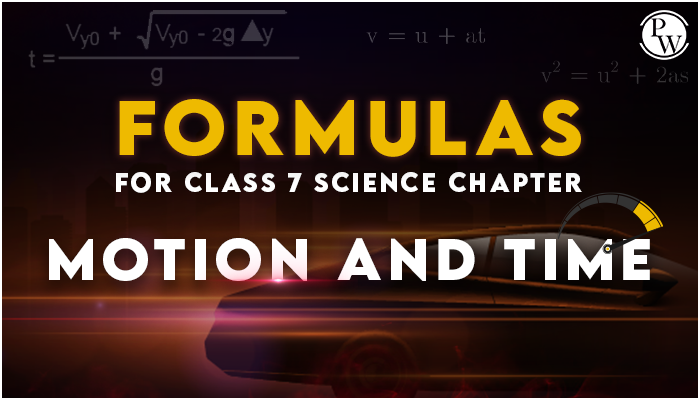
Formulas for Class 7 Science Chapter - Motion and Time
Jun 08, 2022, 16:45 IST
Rest
A body is said to be at rest if it does not changes its position with respect to a fixed point in its surrounding. Example: A book lying on the table will not change its position if it is not disturbed and will be considered to be in a state of rest
Motion
A body is said to be at rest if it changes its position with respect to a fixed point/object in its surrounding. Example: A flying bird, a moving bus, a sailing ship, a walking man, etc. Example: pendulum of wall clock oscillating about the lower most point.
TYPES OF MOTION
Different kinds of motions can be classified in to the following types:
- Translatory Motion: It is a motion in which all points of a moving body move uniformly in the same line motions: r direction through the same distance at the same time. There are two types of translatory
- Rectilinear Motion or Linear Motion: If an object moves along a straight line, its motion is called rectilinear motion. For example, a car moving on a straight road, free falling body towards the earth's surface, etc
- Curvilinear Motion: If an object moves along a curved or circular path, its motion is called curvilinear motion. For example, a car moving along a curved path or javelin thrown by an athlete is a curvilinear motion.
- Circular Motion: The movement of a body along a circular path is called circular motion. It is a special type of curvilinear motion. Example: Whirling of a stone tied to a string.
- Rotatory Motion : A body is said to be in a rotatory motion or a circular motion if it moves about a fixed axis without changing the radius of its motion. Example: the blades of a fan, a spinning top.
- Oscillatory Motion : It is described as the to and fro motion of an object along the same path about its mean position. Example: the motion of the pendulum of a wall clock, the motion of a swing and the piston of an engine.
- Vibratory Motion: There is another type of oscillatory motion in which certain part of the body. always remains fixed while the rest of the body moves to and fro in a particular style about its mean position. This is called a vibratory motion. Example: When we breathe our chest expands and contracts. This motion is called vibratory motion.
- Periodic Motion: A motion which gets repeated after regular intervals of time is called a periodic motion. Example: the swinging pendulum of a wall clock, movement of earth around the sun, etc.
- Non-Periodic Motion: The motion which does not repeat itself after regular interval of time is called non - periodic motion. Example: A footballer running on a field, motion of tides in the sea.
- Multiple Motion: Sometimes, a moving object performs two or more types of motions simultaneously. Such a motion is called multiple motion. Example: A person drawing water from a well, A rider on a bicycle, etc.
- Rolling Motion: The motion in which a body undergoes both translatory as well as rotatory motion. is called as rolling motion. Example: the motion of a cylinder on an inclined plane, movement of a drill.
-
Random Motion: When an object in motion has no specific path and which suddenly changes its motion is called a random motion. Example: Motion of a football on a ground, a flying kite mat have translatory motion at one instant and may have rotatory motion at the very next moment.

UNIFORM AND NON-UNIFORM MOTION
Consider an object moving along a straight line. Let it travel 5 m in the first second, 5 m more in the next second, 5 m in the third second and 5 m in the fourth second. In this case, the object covers 5 m in each second. As the object covers equal distances in equal interval of time, it is said to be in uniform motion. For example, a train moving straight in a particular direction at a constant speed.
The time interval in this motion should be small. In our day-to-day life, we come across motions where objects cover unequal distances in equal intervals of time, it is said to be in non-uniform motion. For example, when a car is moving on a crowded street or a person is jogging in a park.
SPEED, VELOCITY & ACCELERATION
Speed is a physical quantity which gives us an idea about the motion of a body. Suppose we want to compare the motions of the cycle and car on the road. We see that car travels faster than the cycle in the same time-period. Hence, we say that the car moves faster than the cycle.
The distance travelled by a body per unit time is known as the speed of a body.
Speed (s) = Distance travelled (d) / Time taken (t)
Speed is a scalar quantity. Its S.I unit is meter per second (m/s).
Velocity is a physical quantity which gives us an idea about the motion of a body along with its direction. The velocity of a body is the distance travelled by the body in unit time and in a given direction. Hence, Velocity can be defined as displacement per unit time.
Velocity = Displacement / Time
Velocity is a vector quantity. Its S.I unit is meter per second (m/s).
Acceleration: A car starts from rest and attains a constant velocity, say, 50 km/hr. It runs at that velocity for some time. The driver now wants to slow down the car and hence reduces the velocity, so that finally it becomes zero. The various changes in velocity are expressed in terms of acceleration. It is therefore, defined as the rate of change of velocity of a body.
Acceleration = Change in velocity/ Time Acceleration = (Final velocity - Initial velocity)/ Time
Acceleration (a) = (v – u) / t
Acceleration is a vector quantity. Its S.I unit is meter per (second) 2 i.e (m/s 2 ).
Do solve questions given in the NCERT text book with the help of NCERT solutions for class 7 Science . If any students need to take the online test to check their concepts or undertstanding then they can visit Quiz for Motion and Time .
Students can alse get Science Formula for Class 7 from here.
Also Check
Find Below Short Notes of chapter-Motion and Time






